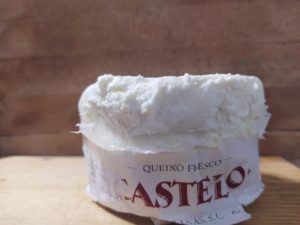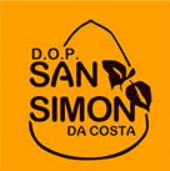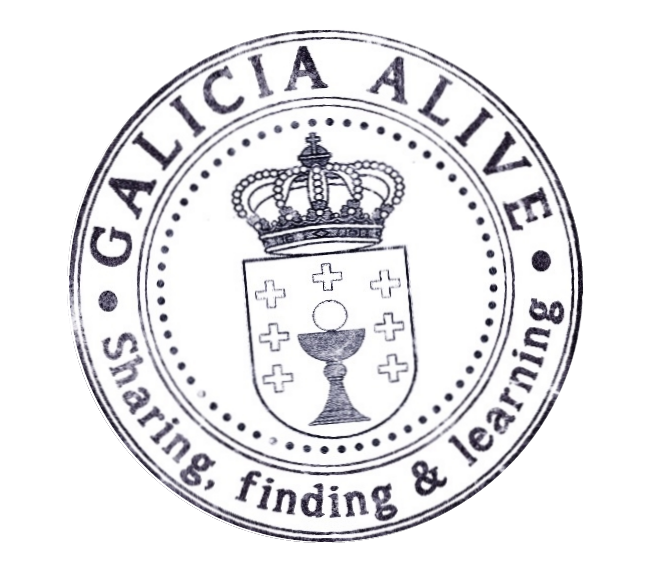Galicia is a land of good quality dairy products. Today we dedicate this publication to cheeses with Protected Designation of Origin ( PDO ) and to the Galician companies that are dedicated to their production and processing. We all know the excellence of these cheeses, but do we know something about their history? We will also talk briefly about it. As the Gadis supermarket says: “ Let’s value it or not show it off, tie de can “.
QUEIXO TETILLA
SAN SIMÓN DA COSTA
ARZÚA-ULLOA CHEESE
So let’s start with a tasting of these delicacies.
QUEIXO TETILLA
Features
The cheese protected by the D.O.P. Queixo Tetilla has well-defined characteristics. It has a conical or conical-convex shape, it has an appreciable, thin and elastic bark, less than 3 mm thick, of a straw yellow color, natural and without molds. The paste inside is soft, creamy and uniform, with few eyes and evenly distributed, ivory-white and yellow. Its aroma, mild and slightly acidic, recalls the raw material, as well as its dairy flavor, butter, slightly acid and with mild salt. The minimum maturation period is seven days after leaving the brine. The weight of the pieces is between 0.5 and 1.5 kg.

History
The oldest sources that cite Tetilla Cheese date from the 18th century, more precisely from 1753, although this dairy product may be earlier. The actual age, therefore, remains to be determined. These first sources are a letter of general content in which the chaplain of San Xoán de Torés, in the Concello de As Nogais (Lugo), named Juan Bermúdez de Novoa, announces the sending of the following merchandise to Marqués de Camarasa to show your affection:
“two bacon, a leg of beef, half a dozen cheeses; three and a half dozen tits; three and a half dozen pig tongues ”
In that same century, Fray Martín Sarmiento compiled different expressions from Galicia in his Collection of Galician voices and phrases, where he quotes the cheese that today protects the PDO Queixo Tetilla. In the second half of the 19th century, Tetilla Cheese appears in the documentation as the Galician cheese par excellence. It was known in various ways according to the existing documentation (literature, press, guides…):
- tity cheese (queixo tetilla)
- tit cheese (queixo teta)
- A Illana cheese, as it got a lot of fame at the A Illana Fair.
- pear cheese (queixo perilla)
Among the documentation from the 19th century where some reference to this product appears are the authors L. Martínez de Padín, Ángel Muro and the great Doña Emilia Pardo Bazán. Even it seems referenced in O’Shea Guide of Spain and Portugal. In the 20th century, it appeared in The guide to good Spanish eating by Dionisio Pérez and in Álvaro Cunqueiro’s work “ Galician Cuisine”.
Legend
In the extraordinary Pórtico de la Gloria of the Cathedral of Santiago, protected by the UNESCO as a World Heritage Site, like the entire Old Town, you can see the scene in which Daniel smiles at Queen Esther ( Queen of Sheba, for some). Apparently, the queen had a large breast size and, that, accompanied by Daniel’s gaze, the ecclesiastical authorities did not like, which ordered to reduce the size of the queen’s breasts. The popular belief tells that it was at that moment when the Galician people, to protest the bishop’s decision, decided to give some of her cheeses the shape of the nipple they currently have. Since then, tetilla cheeses are another hallmark in Galicia and the mutilated breasts of Queen Esther. The Tetilla Cheese is not only an essential product of the Galician tradition, but it is the history of our land made delicacy.
QUEIXO DO CEBREIRO
Features
The aesthetic and flavor characteristics that a must meet to be covered by the D.O.P. Cebreiro refer to its shape, size, color and flavor. All cheeses with D.O.P. Cebreiro must have a mushroom shape or chef’s hat with a cylindrical base of variable diameter and a slightly wider hat with a height of no more than 12 cm. The interior paste is grainy, soft, unctuous and melting on the palate, white in color and slightly acid dairy flavor. Its fat content will be greater than 45% and less than 60%. That of the pieces will be between 0.3 and 2 kg. Its rind is thin or non-existent, firm, without mold and variable in color from white (fresh cheese) to yellow, depending on the degree of maturity. The cured O Cebreiro cheese will have a minimum maturity of 45 days. The pieces have a weight between 0.5 and 2 kg, although the four companies that sell them work in three sizes: 300 g, 1/2 kg and 1 kg. 
History
It seems at least curious that a product with so much history as Queixo do Cebreiro has been on the verge of disappearing. In 1989, only a few women who did it at home knew the method of preparation and, from that moment, their recovery began thanks to the collaboration of restaurateurs, pastry chefs, associations and individuals. Let’s get to know a little more about this cheese of kings. To call this cheese a “ delicacy of kings ” would not be an exaggeration at all. Among the monarchs who succumbed to this Galician delicacy are King Carlos III, the Catholic Monarchs and Isabel de Portugal… In addition, secondly it appears in some documents, this cheese was the fourth most expensive in the world in the seventeenth century. To understand what was the prestige that this cheese enjoyed, we only have to know the following information: In 1762 it was the most expensive cheese in Spain, paying a pound at twelve reales and twelve maravedís. This price made it the fourth most expensive in Europe, after ‘Brie‘ and ‘Marolles‘ and the Swiss ‘Neufchatel‘. In the general history of the Kingdom of Galicia in 1750, Queixo do Cebreiro is defined as ‘ of the best tastes and the most delicate in the world‘. O Cebreiro is one of the best known stops on the Camino de Santiago. For this reason, for centuries, the pilgrims were in charge of spreading the excellence of the cheese of this area. After the beginning of the recovery of this part of our history, the Designation of Galician Quality Product was granted in the year 1991 and an attempt was made to make it known again. This work of yesteryear, which has survived to this day, is exquisitely presented without preservatives or additives.
SAN SIMÓN DA COSTA
The cheeses San Simón da Costa Protected Designation of Origin can be made with milk from cattle of the Galician blonde, brown-alpine, Friesian and their crosses.
Features
The aesthetic and qualitative characteristics that the D.O.P. San Simón da Costa are diverse. Regarding its shape, it looks like something between a top and a bullet. The characteristic smoky smell is essential in its distinction. Regarding the color, it must be yellow-ocher. The texture is somewhat greasy, inelastic and hard, 1 to 3 mm thick. The inner paste has a fine, fatty, semi-hard, semi-elastic and contracted texture, white to yellow in color, smooth to the cut, with a characteristic aroma and flavor, and a not very high number of eyes. Its fat content on a dry layer will be greater than 45% and less than 60%. San Simón da Costa cheese is marketed with a minimum maturity of 45 days, in the case of the 0.8 to 1.5 kg format, and 30 days for the small format or “jester” (0.4 to 0.8 kg). At the end of maturation, it is smoked with birch wood. 
History
The origins of this cheese are also mysterious, perhaps even more so than the other varieties, but we will see that later. During the cultural obscurantism of the Middle Ages there is no reference to the production of this cheese. There are many and very diverse references in the documentation of the 19th century. An interesting review is the one collected in La Aurora del Miño, from September 1857, echoes this representation:
“tremesino wheat, turnips, green peas, green chestnuts that are one of the main foods of the farmer of this province, brandy and sulfuric ether extracted from the strawberry tree, butter perfectly imitated to that of Flanders, San Simón cheeses, flax, medicinal plants… ”
The writer Doña Emilia Pardo Bazán deserves special mention of the reference documentation. In her books she names the San Simón da Costa cheeses on several occasions. During the twentieth century there are numerous appointments to this excellent product. Currently the San Simón da Costa cheese gives is going through a stage of consolidation in new markets both in Europe and on other continents. Legend Legend has it that the true origins of the “San Simón da Costa” cheese go back to the Celtic peoples of the castros that settled in the areas near the mountains of the Sierras de A Carba and O Xistral.
ARZÚA-ULLOA CHEESE
Features
The characteristics of the cheeses that are protected after D.O.P. Arzúa-Ulloa are:
- Arzúa – Ulloa : This cheese has a soft interior paste. It is made with raw or pasteurized milk of the breeds mentioned above, with a minimum maturity of six days and has a lenticular or cylindrical shape with rounded edges. The bark is medium-dark yellow, shiny, thin and elastic. The interior is uniform in color, between ivory white and pale yellow, bright in appearance, with small, angular or rounded eyes and irregular distribution. The size will be between 120 and 260 mm and its height between 50 and 120 mm, although at no time can this be greater than the radius.
- Arzúa-Ulloa de Granja : Made with raw or pasteurized milk coming entirely from cows from the farm itself. The sensory characteristics of these cheeses are the aroma, of fresh milk and yogurt, with the butter aroma appearing as it matures, along with hints of vanilla, cream and nuts. The flavor is slightly salty, with a characteristic point of acidity.
- Arzúa-Ulloa Curado : Made with cow’s milk, raw or pasteurized, it has a minimum maturation period of six months. Its shape is also lenticular or cylindrical and the upper horizontal face can be slightly concave. It has an undifferentiated rind of a very intense, bright yellow color with a greasy appearance. Its weight ranges between 0.5 and 2.0 kg. The diameter is between 120 and 200 mm and the height between 30 and 100 mm. Arzúa-Ulloa Curado cheese is characterized by its hardness, being difficult to cut, and can fracture into chips, mainly at the edges. Its aroma is very intense, of a highly evolved dairy type, with a penetrating odorous sensation and with a certain spice. Its flavor is somewhat salty, with less acidity, and predominantly butter aromas with light notes of vanilla and dried fruits.
History
This one that is traditionally known by three meanings:
- queixo da nabiza
- queixo do tempo dos turnips
- queixo do ano
The first two ways of naming it refer to the period in which it was made. When it was time for nabiza or turnip time, the process of making and curing cheese was carried out.
MAP OF PROTECTED DESIGNATION OF ORIGIN
This map includes the companies that make and produce the cheeses protected by the Protected Designations of Origin represented by their labels.
- Arzúa-Ulloa
- Cebreiro Cheese
- San Simón da Costa
- Tetilla Cheese
HELP US KEEP WRITING
To increase the quality of our posts we need more time. You can help us by buying at Amazon. We leave the following books that may be useful and interesting:


